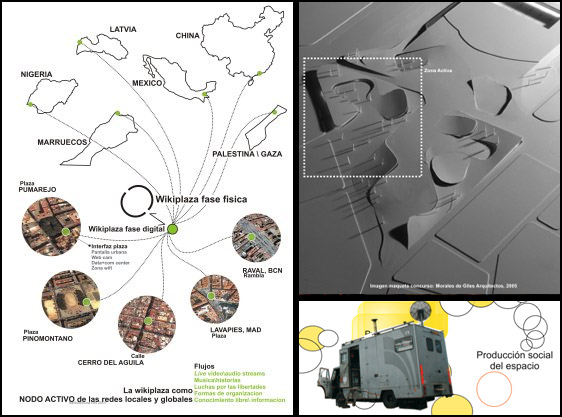

WikiPlaza / Plaza de las Libertades, Sevilla, 2006
Hackitectura.net
with Morales de Giles Arquitectos and Esther Pizarro
WikiPlaza / Plaza de las Libertades Sevilla explores the translation of practices and tools used by digital communities to the construction of a hybrid public space, a citizens’ cyborg territory. The project won the international contest for setting up and building a space for freedom (Concurso internacional de ideas para la ordenación y construcción de un espacio para las libertades) held by the Seville City Government. It is a 30,000 m2 public space and a 3,000 m2 sociocultural building across from the Santa Justa High Speed Train Station, one of the main entrance points to the contemporary city, one of the primary intermodal nodes.
The urban development plan consists of a topological, fluid, non-hierarchical space. The contribution of Hackitectura.net is related to the incorporation of a multi-layered architecture of networks, hardware, software and digital data that permit the social, participatory production of a public space, as imagined by Lefebvre or the Situationists. The space would be a laboratory for citizens to explore the social uses of technologies, especially matters such as architecture as an operating system, public space as an active node on the Web, building social and urban interfaces, electromagnetic public space, the detournement of a video surveillance system via permanent public Web cast (the square as Mille Plateaux ), the invention of new relationships between electronic and natural flows (a garden of microchips), or building public space like a wiki. This is the development of the concept of WikiPlaza.

The digital project proposes the implementation in a permanent public space of experiences accumulated during the second decade of the world wide web by social movements, which may include the development of free software, Indymedia, the hackmeetings movement, temporary medialabs, GISS (the global network for free streaming), social centres occupied by squatters, practices considered in a complex sense – sociotechnical, biopolitical, or ecosophical; that is, as generators of new forms of habitation, of being in the world and society.
As opposed to traditional architectural and urban development approaches, "Freedom Square" (la plaza de las libertades) is conceived as a dynamic agencing of physical spaces, social networks, and electronic flows. The project offers a basic infrastructure for the development of an emerging system, a new type of institution, that we are beginning to see in different places (Hangar, Medialab Prado, social centres) where new forms of autonomy are explored; that is, of relationships between the Administration and the communities producing the space.
